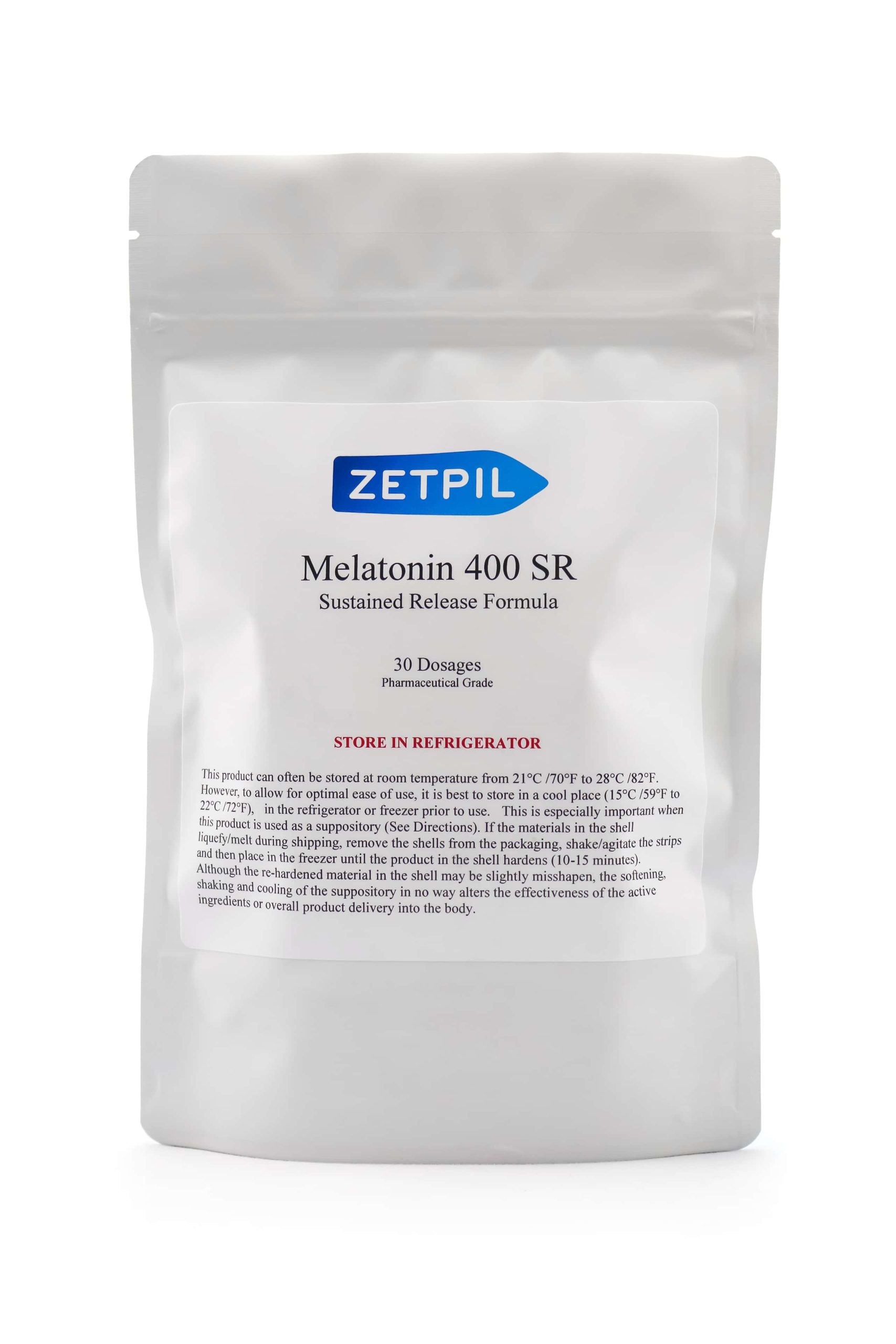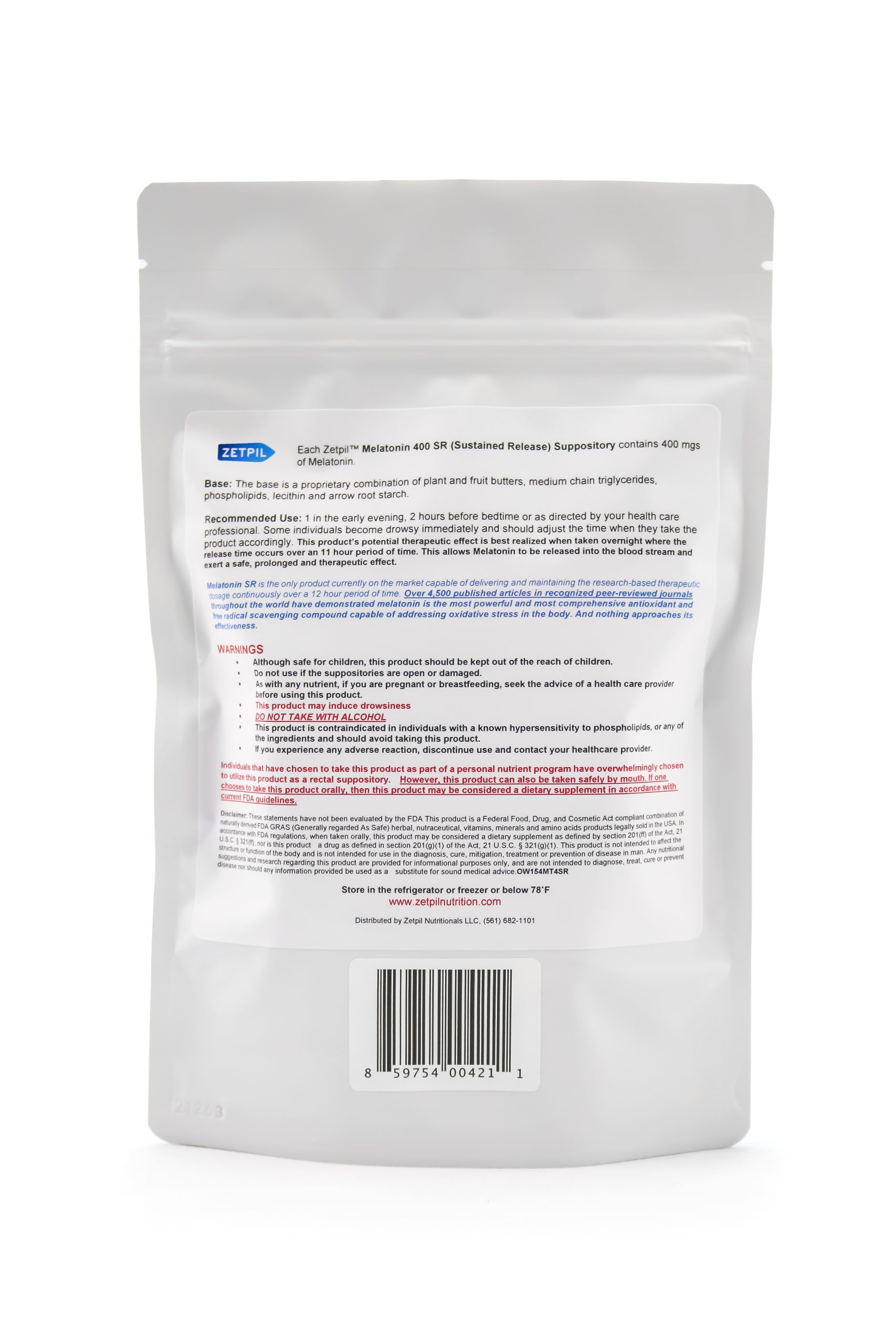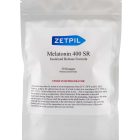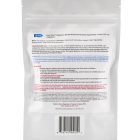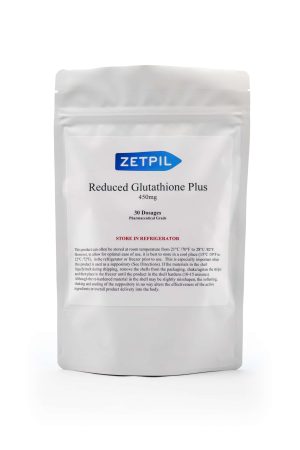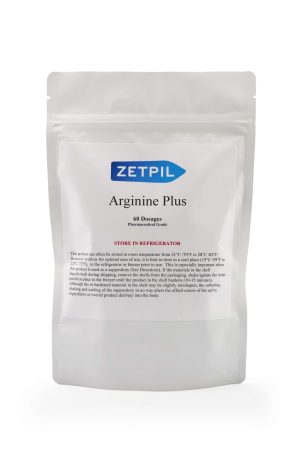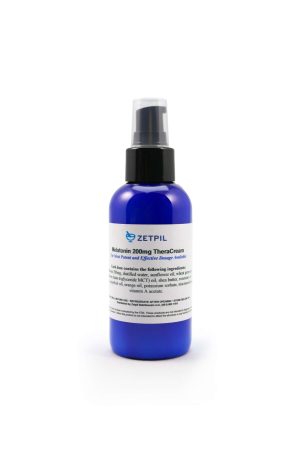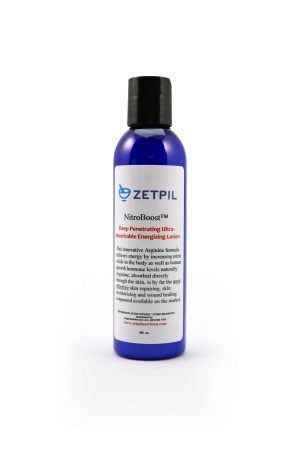Description
Zetpil™ Suppository Advantage
Zetpil™ delivers nutrition via the rectum with the use of suppositories that have a unique, all- natural formulated base that has revolutionized not only this mode of delivery, but also the ability to obtain nutrients in a far more efficacious method. These suppositories are a result of combining natural ingredients with a non-irritating, rapid melting (5-6 minutes), readily absorbable (superior retention), antioxidant base material (free radical scavenging ability) and delivers the nutrients directly into the bloodstream in less than 20 minutes in a highly effective manner. Oral supplements are exposed to the hazards of stomach acid, digestive enzymes, food-related breakdown, first pass metabolism, and other bioavailability issues in the gastro-intestinal system.
Additionally, many raw materials simply have a very low bioavailability , and only achieve around 10% or less (commonly <1%) absorption rates, even if the patient is in optimal health condition. Compromised health, age, or certain conditions that result in inability to take oral nutrients often preclude these patient populations from obtaining the necessary nutrition to stay healthy which often exacerbates chronic health issues.
Zetpil™ suppositories, as well as deep penetrating creams, are a NOW solution to delivering the necessary nutrients to patients, on a daily basis, that is both easy, comfortable and cost effective. The safety and noticeable effectiveness of these products will far outweigh any initial hesitation you have regarding this mode of delivery.
**NOTE: Melatonin currently is unavailable as intramuscular injections, nebulizer (nasal mist) or by intravenous administration anywhere in the world. Accordingly, the Zetpil ™ Melatonin Suppository is the only therapeutic melatonin option currently available.
What makes our Melatonin product different?
The Zetpil™ difference lies in our product’s ability to achieve therapeutic dosages via an alternate mode of delivery. The impression of most lay people and physicians alike that the low oral dosages (2-10mgs) that help individuals sleep will also be able to exert melatonin’s powerful antioxidant effect is false. Nothing could be further from the truth!
Oral delivery of melatonin results in extremely low dosages absorbed as a result of low oral bioavailability, GI and liver metabolism of the compound, and lack of systemic circulation of therapeutic dosages. It has been repeatedly proven in the research that dosage levels that trigger antioxidant activity cannot be achieved with oral delivery of melatonin. Supraphysiologic dosages (higher amounts than the body can make or ingest through diet) MUST be achieved in order for melatonin to exert its antioxidant effect. Research has hailed melatonin as the closest thing to a universal panacea (ie: cure for all ailments) ever researched by modern medicine which was the driving force for Zetpil™ to develop its Melatonin suppository and capitalize on all its potential health benefits.
What makes this product truly revolutionary is that therapeutic dosages of pharmaceutical grade Melatonin, embedded into our proprietary suppository base, can be delivered directly into the blood stream (via the many blood vessels that exist in the rectum), potentially affecting an elevation of the serum melatonin levels. Suppositories offer patient-friendly, cost-effective, and a natural, safe opportunity for repeated dosages of melatonin to be taken indefinitely! This breakthrough form of delivering melatonin truly raises the bar in effective antioxidant therapy for the patient population who desire an effective, affordable and potent antioxidant solution.
What is Melatonin?
What is Melatonin?
Melatonin (N-acetyl-5-methoxytryptamine) is an indolamine (neurotransmitter) which is synthesized not only within the pineal gland in the brain, but has also been shown to be synthesized in many other parts of the body including, but not limited to, organs, the eye, gut, bone marrow, skin and immune cells. The role of melatonin in circadian rhythm disturbances and sleep disorders is well established.
However, in the last several years, over 4,500 publications in peer-reviewed journals in the National Library of Medicine have confirmed melatonin, at higher dosages, to be the most powerful antioxidant in existence and the only universal free radical scavenger.
Patient and professional understanding of this unique and powerful signaling molecule must extend beyond jet lag and sleep aid. Some of its multiple beneficial functions may include powerful antioxidant, DNA protectant, immune function gatekeeper, and a natural oncostatic (anti-cancer) molecule. The research conducted in these regards has unequivocally documented melatonin’s ability to detoxify ALL harmful free radicals which cause molecular damage leading to disease and dysfunction.
Free Radicals & Oxidative Stress
What are “free radicals” and “oxidative stress”?
During respiration your body constantly reacts with oxygen for your cells to produce energy. A natural consequence of this activity is that highly reactive, unstable molecules are produced known as “free radicals”. Approximately 80% of all free radical production in the body is a result of this essential energy-generating process. Environmental stresses (ie: UV damage, pollution, radiation), emotional stress, inflammation and pharmaceutical drugs also directly cause the production of free radicals.
These free radicals (also called reactive oxygen/nitrogen species- ROS/RNS) are the nasty organic molecules responsible for aging, DNA and tissue damage, and many other types of diseases. They are called “free” because they drift around the body with at least one unpaired electron in its outermost shell until they stabilize, and “radical” because there is a large compilation of molecules from which they can snatch electrons from. As these free radicals accumulate they begin to overwhelm the body’s ability to safely stabilize them which results in oxidative stress, or damage.
How can you minimize this destructive damage?
Antioxidants. Powerful antioxidants help these unstable molecules from binding with healthy molecules. However, there is a catch. What constitutes a “powerful” antioxidant may not be what you have been led to believe. One of the biggest myths touted by the nutrition industry is that all antioxidants are created equal and nothing could be further from the truth.
Many antioxidant vitamins commonly praised in mainstream medicine, such as C, E and A, are considered classical antioxidants and, in theory, are supposed to be effective in combating free radical damage. However, in the process of squelching free radicals these nutrients transform from a reduced state to an oxidized state, lose their spare electron (now molecularly unstable) and ultimately become free radicals themselves! During this process of transforming from an antioxidant to a free radical these classical antioxidants also DEPLETE one of the most basic cellular antioxidants- glutathione. There is no commonsense benefit to exhausting glutathione, especially since glutathione is far more powerful than the classic antioxidants.
Melatonin’s unique physical properties also set it apart from classical antioxidants. Its small molecular size and amphiphilic properties (able to be dissolved in both fat and water) allow this molecule to penetrate all cells and cellular compartments, most notably the mitochondria. Given that much evidence exists to show a direct relationship between mitochondrial dysfunction, aging, oxidative damage and low melatonin concentrations, melatonin should justly take its place as the most powerful antioxidant known to mankind.
References
References
There are more than 10,000 available articles in the National Library of Medicine studying melatonin. We have referenced only some which we feel are valuable. To learn more, please visit: http://www.ncbi.nlm.nih.gov/pmc/?term=melatonin
Melatonin in Alzheimer’s Disease
Li Lin, et al
Int J Mol Sci. 2013 July; 14(7): 14575–14593
http://www.ncbi.nlm.nih.gov/pmc/articles/PMC3742260/
Neurobiology, Pathophysiology, and Treatment of Melatonin Deficiency and Dysfunction
Scientific World Journal 2012; 2012: 640389
Rüdiger Hardeland
http://www.ncbi.nlm.nih.gov/pmc/articles/PMC3354573/
Intracellular redox state as determinant for melatonin antiproliferative vs cytotoxic effects in cancer cells
Sánchez-Sánchez AM, et al
Free Radic Res 2011 Nov; 45(11-12):1333-41
http://www.ncbi.nlm.nih.gov/pubmed/21923620
Melatonin combats molecular terrorism at the mitochondrial level
Russel J. Reiter, et al.
Interdiscip Toxicol 2008 September; 1(2): 137–149
http://www.ncbi.nlm.nih.gov/pmc/articles/PMC2993480/pdf/ITX-1-137.pdf
The Role of Mitochondria in Brain Aging and the Effects of Melatonin
Germaine Escames, et al
Curr Neuropharmacol 2010 September; 8(3): 182–193
http://www.ncbi.nlm.nih.gov/pmc/articles/PMC3001212/pdf/CN-8-182.pdf
One molecule, many derivatives: a never-ending interaction of melatonin with reactive oxygen and nitrogen species?
Tan DX, et al
J Pineal Res 2007 Jan; 42(1):28-42
http://www.ncbi.nlm.nih.gov/pubmed/17198536
Melatonin in bacterial and viral infections with focus on sepsis: a review
Srinivasan V, et al
Recent Pat Endocr Metab Immune Drug Discov 2012 Jan; 6(1):30-9
http://www.ncbi.nlm.nih.gov/pubmed/22264213
Basic mechanisms involved in the anti-cancer effects of melatonin
Mediavilla MD,et al
Curr Med Chem 2010; 17(36):4462-81
http://www.ncbi.nlm.nih.gov/pubmed/21062257
Melatonin: An Established Antioxidant Worthy of Use in Clinical Trials
Ahmet Korkmaz, et al
Mol Med 2009 Jan-Feb; 15(1-2): 43–50
http://www.ncbi.nlm.nih.gov/pmc/articles/PMC2582546/pdf/mol-15-43.pdf
Melatonin Metabolism in the Central Nervous System
Rüdiger Hardeland
Curr Neuropharmacol 2010 September; 8(3): 168–181
http://www.ncbi.nlm.nih.gov/pmc/articles/PMC3001211/pdf/CN-8-168.pdf
Chemical and physical properties and potential mechanisms: melatonin as a broad spectrum antioxidant and free radical scavenger
Tan DX, et al
Curr Top Med Chem 2002 Feb; 2(2):181-97
http://www.ncbi.nlm.nih.gov/pubmed/11899100
Advances in the Research of Melatonin in Autism Spectrum Disorders: Literature Review and New Perspectives
Int J Mol Sci. Oct 2013; 14(10): 20508–20542
Sylvie Tordjman, et al
http://www.ncbi.nlm.nih.gov/pmc/articles/PMC3821628/
Melatonin: An Underappreciated Player in Retinal Physiology and Pathophysiology
Exp Eye Res 2012 October; 103: 82–89
Gianluca Tosini, et al
http://www.ncbi.nlm.nih.gov/pmc/articles/PMC3462291/
Hepatoprotective actions of melatonin: Possible mediation by melatonin receptors
World J Gastroenterol. 2010 December 28; 16(48): 6087–6097
Alexander M Mathes, et al
http://www.ncbi.nlm.nih.gov/pmc/articles/PMC3012585/
Influence of the Circadian System on Disease Severity
Litinski M, Scheer FA, Shea SA
Sleep Med Clin 2009 Jun 1; 4(2):143-163
http://www.ncbi.nlm.nih.gov/pmc/articles/PMC2733366/pdf/nihms-128443.pdf
Abnormal melatonin synthesis in autism spectrum disorders
Melke J, et al
Mol Psychiatry 2008 Jan; 13(1):90-8
http://www.ncbi.nlm.nih.gov/pmc/articles/PMC2199264/pdf/halms166901.pdf
The glutathione system and its regulation by neurohormone melatonin in the central nervous system
Cent Nerv Syst Agents Med Chem 2010 Dec 1; 10(4):287-97
Limón-Pacheco JH, et al

